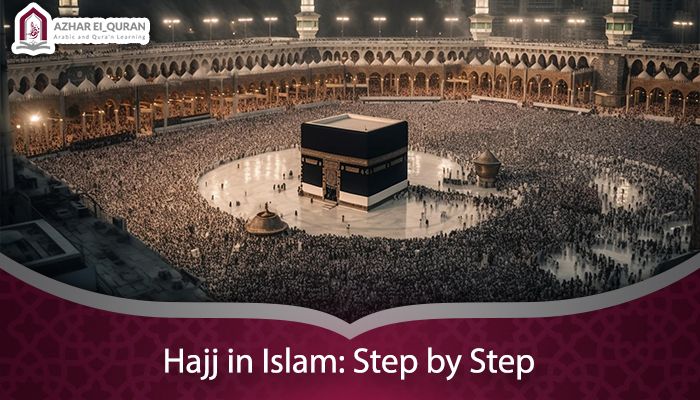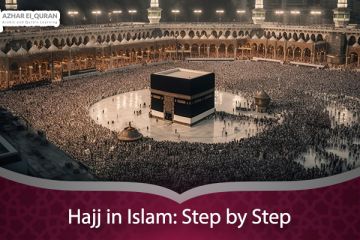Hajj is an annual Islamic pilgrimage obligation to Mecca, one of the Five Pillars of Islam. Every Muslim, if able, must perform the Hajj at least once in their lifetime. Hajj is a profound spiritual experience that unites Muslims from all over the world. Every year, millions of Muslims from around the world embark on a sacred journey that brings them closer to Allah (SWT) and their Islamic faith.
This journey, known as Hajj, is not just a physical act but a deeply spiritual and transformative experience. The pilgrimage to Mecca in Saudi Arabia, located in Saudi Arabia, is one of Islam's most significant religious obligations. Ideal for Muslims planning their sacred pilgrimage to Mecca in Saudi Arabia.
This article explores the step-by-step guide to performing Hajj in Islam. Learn about its meaning, importance, rituals, and spiritual significance.
Define Hajj in Islam
Hajj in Islam is the annual Islamic pilgrimage to the holy city of Mecca (Makkah) in Saudi Arabia, which every adult Muslim who is physically and financially able must undertake at least once in their lifetime. It is pillar of the five pillars of Islam, which form the foundation of a Muslim’s deen (faith). Hajj takes place during the month of Dhul Hijjah, the twelfth month of the Islamic lunar calendar.
The meaning of Hajj in Islam is deeply rooted in submission to the will of Allah, following in the footsteps of Prophet Ibrahim (Abraham) and Prophet Muhammad (peace be upon them). Hajj, Unlike Umrah, can be performed at any time of the year. Hajj is the annual Islamic pilgrimage performed during specific days in Dhu al-Hijjah. annual Islamic pilgrimage is a profound spiritual experience that unites Muslims from all over the world.
The pilgrimage (hajj) rite starts on the 8th of Dhū al-Ḥijjah (the final month of the Islamic calendar) and concludes on the 13th. The hajj is the obligation for all physically and financially capable Muslims, provided their absence does not burden their family. Pilgrims unable to Hajj themselves may appoint a proxy.
Importance of Hajj in Islam
Hajj in Islam, annual Islamic pilgrimage to Mecca (Makkah) in Saudi Arabia unite in a series of religious rites. Hajj holds immense significance within the Islamic faith. The significance of the Hajj in Islam cannot be overstated. It is a mandatory act of worship that reflects complete devotion to Allah. Hajj in Islam promotes the unity of the Ummah, as Muslims from all corners of the globe, regardless of race, language, or nationality, gather in a single place, wearing the same simple white garments known as Ihram, standing equal before their Creator.
The annual Hajj is also Islamic pilgrimage a chance for a spiritual rebirth. It is said that a pilgrimage properly performed cleanses the pilgrims of their sins, returning them as pure as the day they were born.
The Prophet Muhammad (peace be upon him) said in authentic hadiths, “Whoever performs Hajj and does not engage in sexual relations, obscene language, or arguments, will return as free of sin as the day he was born.”
In addition to spiritual rewards, Hajj is a sign of obedience to God and acknowledgment of the values of Islam. It symbolizes unity, humility, and the global nature of the Muslim faithful.
The Basic Pillars of Hajj in Islam
Hajj is an Islamic pilgrimage made to the Kaaba, the "House of Allah," in the sacred city of Mecca (Makkah) in Saudi Arabia and It is pillar of the Five Pillars of Islam. There are essential elements or pillars of Hajj that every Muslim must fulfill.
These include:
Ihram: - Entering into a state of ritual purity and making the niyyah to Hajj.
Standing at Arafah (Wuquf Arafah) – The main ritual of Hajj, where pilgrims stand in prayer and reflection at the plain of Arafah.
Tawaf al-Ifadah– Circumambulating the Kaaba seven times in the Masjid al-Haram.
Sa’i – Walking seven times between the hills of Safa and Marwah, recalling the struggle of Hajar, the wife of Prophet Ibrahim.
Shaving or trimming the hair – As an act of humility and renewal.
Order and timing – Each act must be done in its proper sequence and during specific days.
Failing to complete these basic acts could invalidate the Hajj in Islam, and in some cases, one would have to repeat the entire pilgrimage.
Hajj is the annual Islamic pilgrimage to the holy city of Makkah, to every Muslim who is physically able to it at least once in their lifetime.
How to Perform Hajj in Islam Step by Step
Hajj is an annual sacred pilgrimage, performed by Muslims. Performing Hajj involves a series of deeply symbolic rituals spread over several days, specifically from the 8th to the 13th of Dhul Hijjah.
1. Ihram (8th Dhul Hijjah)
Before arriving in the holy city of Mecca (Makkah) in Saudi Arabia, pilgrims must enter into the state of Ihram, a sacred condition marked by wearing white seamless garments for men and modest attire for women. They make the intention for Hajj and recite the Talbiyah: “LabbaykaAllahummalabbayk.”, declaring their readiness to serve Allah.
This is the beginning of the Tamattu type of Hajj in Islam (common among non-Saudis), where Umrah is performed first, followed by Hajj.
2. Tawaf after Arrival in Mecca
Once in Mecca (Makkah) in Saudi Arabia, pilgrims' ritual Tawaf al-Qudum, making seven rounds around the Kaaba, located. This act symbolizes the eternal movement of the universe around its center.
3. Sa’i Between Safa and Marwah
Next, they perform Sa’i, walking briskly between the two hills. This ritual commemorates the desperate search for water by Hajar for her son Ismail, which resulted in the miraculous emergence of the Zamzam spring.

4. Mina (8th Dhul Hijjah)
Pilgrims then travel to Mina, a tent east of Mecca in Saudi Arabia, where they spend the day in preparation for the central rites of Hajj.
5. Day of Arafah (9th Dhul Hijjah)
The next day is the most crucial part of Hajj — the Day of Arafah. Pilgrims gather at the plain of Arafah to pray, worship, and seek forgiveness. The Prophet Muhammad (peace be upon him) delivered his final sermon here. Missing Arafah invalidates the entire Hajj.
6. Muzdalifah (Night of 9th Dhul Hijjah)
After sunset, pilgrims head to Muzdalifah, where they perform Maghrib and Isha prayers, rest, and collect pebbles for the next ritual. Spending the night here is a required act.
7. Ramy al-Jamarat (10th Dhul Hijjah)
In Mina, pilgrims performed the stoning ritual by throwing seven pebbles at the largest pillar (Jamrah al-Aqaba), symbolizing the rejection of evil. This act recalls the moment when Ibrahim threw stones at Satan.
8. Animal Sacrifice
Pilgrims then make a sacrifice, commemorating Ibrahim's willingness to sacrifice his son for Allah’s command. Today, this is often carried out through organized systems across Saudi Arabia.
9. Shaving the Head or Trimming Hair
Male pilgrims shave their heads or trim their hair; women cut a small portion. This act reflects humility and spiritual cleansing.
10. Tawaf al-Ifadah
Pilgrims return to Mecca in Saudi Arabia to perform another Tawaf and Sa’i, marking the completion of the main rites. It is a part of the Hajj.
11. Ramy al-Jamarat (11th to 13th Dhul Hijjah)
Over the next two days, pilgrims continue the stoning ritual at all three pillars (Jamarat), symbolizing resistance to evil in life. They may leave on the 12th or 13th after completing this duty.
12. Tawaf al-Wada’
Before leaving holy Mecca in Saudi Arabia, pilgrims perform the farewell Tawaf, known as Tawaf al-Wada’, a final act of worship showing love for the Kaaba and the desire to return.
Facts About Hajj
Hajj is the pilgrimage that every sane Muslim must make at least once in his or her lifetime if they are able, and traveling to Mecca is the most spiritual event for a Muslim in Saudi Arabia. Every year, millions of Muslims from around the world. Hajj is expected to be performed once in a lifetime, only by those who can physically and financially afford it. Hajj dates shift yearly due to the calendar; in 2025, it is projected to begin Evening of Wed, 4, 2025 – Mon, June 9, 2025.
The Ka'ba is believed to have been built by Prophet Ibrahim and his son Ismail, making it the most sacred structure in Islam. The flow of millions of people during the Hajj (pilgrimage) is a symbol of Islam’s strength, unity. Performing Hajj is a direct obligation from Allah, emphasized through the Quran.
Those who complete Hajj (pilgrimage) sincerely are promised Jannah (paradise) as a reward. The Haramain (the two sacred mosques in Mecca and Medina) host the most critical events of Islamic history and worship. Hajj is the annual pilgrimage to every Muslim must make at least once in his or her lifetime. The Leading platform, Azhar El-Quran, offers resources to help Muslims spiritually prepare for Hajj and understand its rituals, meanings, and actions.
















